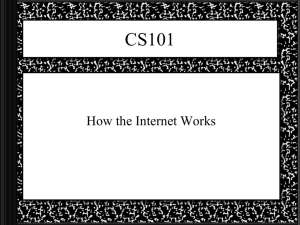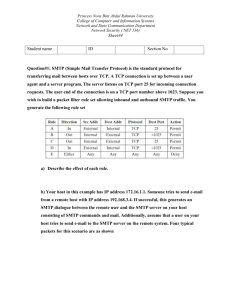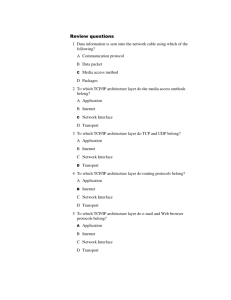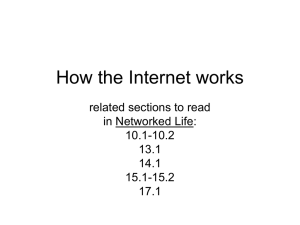Connecting with Computer Science Chapter 5 Review
advertisement
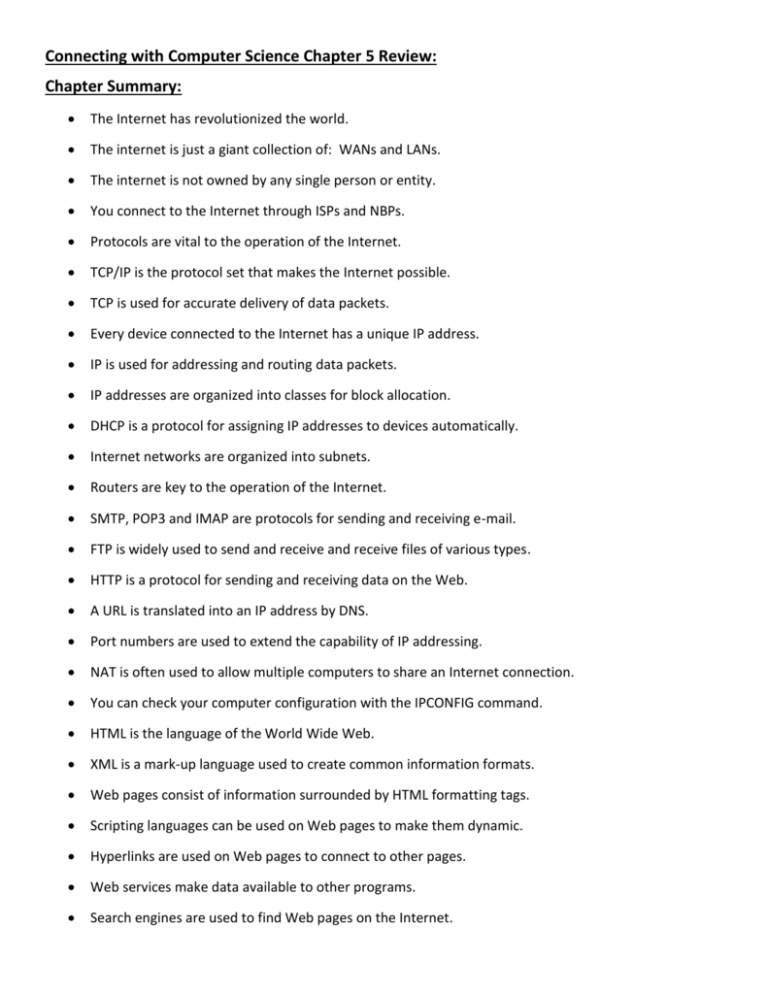
Connecting with Computer Science Chapter 5 Review: Chapter Summary: The Internet has revolutionized the world. The internet is just a giant collection of: WANs and LANs. The internet is not owned by any single person or entity. You connect to the Internet through ISPs and NBPs. Protocols are vital to the operation of the Internet. TCP/IP is the protocol set that makes the Internet possible. TCP is used for accurate delivery of data packets. Every device connected to the Internet has a unique IP address. IP is used for addressing and routing data packets. IP addresses are organized into classes for block allocation. DHCP is a protocol for assigning IP addresses to devices automatically. Internet networks are organized into subnets. Routers are key to the operation of the Internet. SMTP, POP3 and IMAP are protocols for sending and receiving e-mail. FTP is widely used to send and receive and receive files of various types. HTTP is a protocol for sending and receiving data on the Web. A URL is translated into an IP address by DNS. Port numbers are used to extend the capability of IP addressing. NAT is often used to allow multiple computers to share an Internet connection. You can check your computer configuration with the IPCONFIG command. HTML is the language of the World Wide Web. XML is a mark-up language used to create common information formats. Web pages consist of information surrounded by HTML formatting tags. Scripting languages can be used on Web pages to make them dynamic. Hyperlinks are used on Web pages to connect to other pages. Web services make data available to other programs. Search engines are used to find Web pages on the Internet. Connecting with Computer Science Chapter 5 Review: Key Terms: ARIN: (177) ASP: (193) Bot: (196) CGI: (193) DHCP: (177) DHTML: (193) DNS: (183) Domain Name: (183) FTP: (173) HTML: (188) HTTP: : (173) Hyperlink: (191) IANA: (177) IMAP: (181) IP: (174) IP Address: (175) IPCONFIG: (187) IPv4: (175) IPv6: (176) ISP: (172) JavaScript: (193) JSP: (193) Metadata: (194) NAT: (186) NBP: (172) Perl: (193) PHP: (193) POP: (172) POP3: (181) Port Number: (185) Python: (193) Router: (178) Search Engine: (195) SGML: (194) SMTP: (173) Spider: (196) SSH: (182) Subnet: (177) TCP: (174) TCP/IP: (174) Time to Live: (179) URL: (183) VBScript: (193) Web Server: (188) Web Service: (194) XML: (194) (American Registry of Internet Numbers) The U.S. organization that assigns IP address numbers for the country and its territories. A Web service technology that combines features of HTML and JavaScript or VBScript programming code; Used on a Web server to create Web pages dynamically. A small program also called a spider or crawler that access web sites to gather their content for search engine indexes. An older Web server technology used for dynamic Web page creation. (Dynamic Host Configuration Protocol) A communication protocol that automates assigning IP addresses in an organizations network. An extension of HTML tags and options for producing Web pages that are responsive to user interaction. A method of translating Internet domain names into IP addresses; DNS servers are servers used in this process. A name used to locate the IP address of an organization or other entity on the Internet, such as www.yahoo.com A protocol designed to exchange text and binary files via the Internet. Markup symbols or codes inserted in a file that specifies how the material is displayed on a Web page. A protocol designed for transferring files (primarily content files) on the world wide web. A link that allows users to select a connection from one word, picture or information object to another. (Internet Assigned Numbers Authority) The organization under contract with the U.S. government to oversee allocating IP addresses to ISPs (Internet Message Access Protocol) A standard protocol for accessing e-mail from a mail server. The protocol that provides for addressing and routing internet packets from one computer to another. A unique 32 bit number assigned to network devices that use Internet protocol. A Windows command line utility that can be used to display currently assigned network settings. Version 4 of Internet protocol, the most widely used version of IP. Version 6 of Internet protocol has more capabilities than version 4 including providing for far more IP addresses. A company that provides access to the Internet and other related services, such as Web site building and virtual hosting. An interpreted programming or script language from Netscape; Somewhat similar in capability to Microsoft VBScript. Comparable with Microsoft’s ASP technology, except it runs only programs written in Java. In XML and in database systems, information about characteristics of the data in a file; sometimes called data about data. Used to translate an IP address to an inside IP address; NAT is often used to allow multiple computers to share one internet connection. (National Backbone Provider) A provider of high-speed network communication lines for use by ISPs. A script programming language similar in syntax to the C language; often used to develop CGI dynamic Web pages. In Web programming, a free script language and interpreter used primarily on Linux Web Servers. An access point to the internet. (Post Office Protocol V 3) The most recent version of a standard protocol for receiving e-mail from a mail server. An addressing mechanism used in TCP/IP as a way for a client program to specify a particular server program on a network computer and to facilitate Network Address Translation. An interpreted OOP similar to Perl that has gained popularity in recent years. A device or software in a computer that determines the next network point to which a packet should be forwarded. A program, usually accessed on the Web that gathers and reports information available on the Internet. (Standard Generalized Markup Language) A standard for how to specify a document markup language or tag set. A TCI/IP-related, high level protocol used in sending e-mail. Also called a bot or crawler, a program that visits Web sites and reads their pages and other information to create entries for a search engine index. A network protocol for secure data exchange between two networked devices, usually in a Linux environment. A portion of a network that shares part of an address with other portions of the network and is distinguished by a subnet number. An OSI Transport layer, connection orientated protocol designed to exchange messages between network devices. The suite of communication protocols used to connect hosts on the internet A field in the IP header that enables routers to discard packets that have been traversing the network for too long. The English-like address of a file accessible on the Internet An interpreted script language from Microsoft that is a subset of the VB programming language often used by Web browsers and ASP. A program running on a computer that responds to http requests for Web pages and returns the Web pages to the requesting client. Programming and data on a Web server designed to make data available to other Web programs. A markup language designed to create common information formats and share the formats and data on the World Wide Web. Connecting with Computer Science Chapter 5 Review: Test yourself: 1.) The Internet is made up of a collection of: _______________ and ________________? LANS and WANS 2.) What does the acronym ISP stand for? Internet Service Provider 3.) What is an NBP? A provider of high-speed network communication lines for use by ISPs. 4.) What is the protocol SMTP used for? Simple Mail Transfer Protocol 5.) Which Internet protocol is responsible for reliable delivery of data from one computer to another? TCP is responsible for reliable delivery of data from one computer to another 6.) Which Internet protocol manages sequencing data packets? IP manages sequencing data packets 7.) Which Internet protocol maintains port information? TCP/IP maintains port information 8.) What is the size, in bits of an IPv4 address? The size, in bits of an IPv4 address IS 32 BITS 9.) Which IPv4 class allows the greatest number of hosts? IPv6 allows the greatest number of hosts. 10.) What is the IP address 255.255.255.255 reserved for? The IP address 255.255.255.255 reserved for network broadcasts. 11.) What is the regional agency that assigns IP addresses for the U.S. and its territories? ARIN 12.) What is the function of DHCP in networking? The function of DHCP in networking is to assign IP addresses. 13.) What is a router? A router is a device or software in a computer that determines the next network point to which a packet should be forwarded. 14.) What prevents TCP/IP packets from bouncing from router to router forever? Time to live prevents TCP/IP packets from bouncing from router to router forever. 15.) What is the purpose of FTP? The purpose of FTP is to exchange text and binary files via the Internet. 16.) Which network device is used to resolve domain names into IP addresses? DNS is a network device is used to resolve domain names into IP addresses. 17.) What is the Windows command-line utility to check your computer’s network configuration? IPCONFIG is the Windows command-line utility to check your computer’s network configuration. 18.) What is the language of the World Wide Web? HTML is the language of the World Wide Web. 19.) What programs are used to “crawl” the web? Programs are used to “crawl” the web include: Google Yahoo Webcrawler Altavista Bing Connecting with Computer Science Chapter 5 Review: Practice Exercises 1.) The Internet is owned by: D. None of the above. 2.) Internet providers maintain a switching centre called a C. Router. 3.) The purpose of HTTP is to: B. Transfer Web pages 4.) Which of the following is not an Internet- related protocol? B. HTML 5.) How many possible ports are allowed in TCP: B. 16 6.) Which portion of the TCP/IP protocol suite provides error detection and correction? C. Both 7.) How many different hosts can be granted a Class A IP address allocation? D. 126 8.) Which Internet protocol is used to assign IP addresses dynamically? B. DHCP 9.) Routers are critical to the operation of the Internet. A. True 10.) Which Internet component is responsible for decrementing the TTL field? D. Packet 11.) Which of the following is an example of a high-level protocol? D. SMTP 12.) Which of the following protocols makes the Web possible? C. HTTP 13.) Which of the following is an example of a URL? A. www.cengage.com 14.) How many DNS servers does the Internet have? C. Thousands 15.) What is the standard port number for HTTP? D. 80 16.) How many IP addresses are presented to the Internet when NAT is used? A. 1 (pg 34) 17.) Which of the following is an example of an example of an HTML tag? B. <HTML> 18.) Which HTML tag is used to provide links to other pages? C. <A> 19.) XML is just another name for HTML B. False 20.) Bots are used by______________ to crawl the World Wide Web. B. Search Engines



